Precision Mesh Offsetting with MeshLib
Mesh Offsetting is an important technique in 3D geometry processing. It creates a surface that’s parallel to the original mesh at a set distance. This allows for exact growth or shrinkage of solid objects. Many industries use this process. In 3D printing, it helps ensure proper wall thickness and support structures.
MeshLib offers advanced Mesh Offset features that improve 3D modeling and manufacturing. This useful tool lets users make parallel surfaces at specific distances from the original meshes. It’s crucial for industries like 3D printing, CNC machining, and injection molding. MeshInspector’s Offset tool gives users great control over surface thickness. This makes work more precise and efficient in many areas.
What Mesh Offsetting modes does MeshLib offer?
MeshInspector’s Offset tool has five different offset modes, each designed for specific modeling needs:
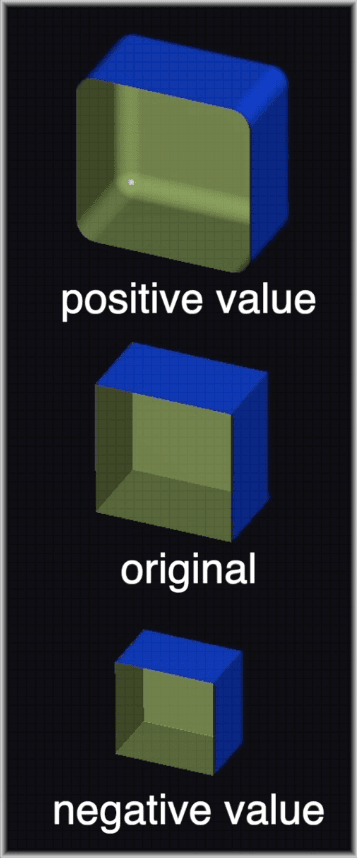
1. Entire Model Offset Mode
- Purpose: Offsets the whole mesh evenly
- Function: Positive values expand, negative values contract

2. Thickening Mode
- Purpose: Adds an extra surface layer
- Function: Positive values add an outer layer, negative values add an inner layer
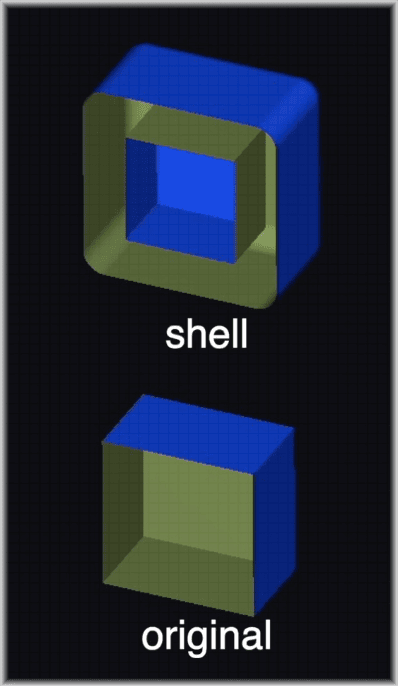
3. Shell Mode
- Purpose: Makes two new surfaces and removes the original mesh;
- Ideal for: Creating hollow parts in mold making.
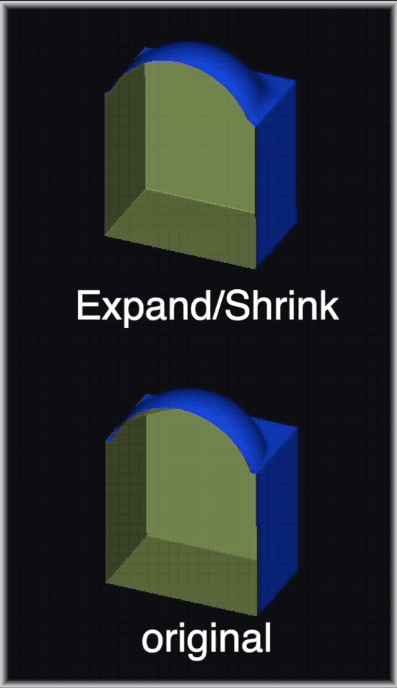
4. Expand/Shrink Mode
- Purpose: Smooths inward curves and increases volume;
- Process: First expands, then shrinks the mesh.
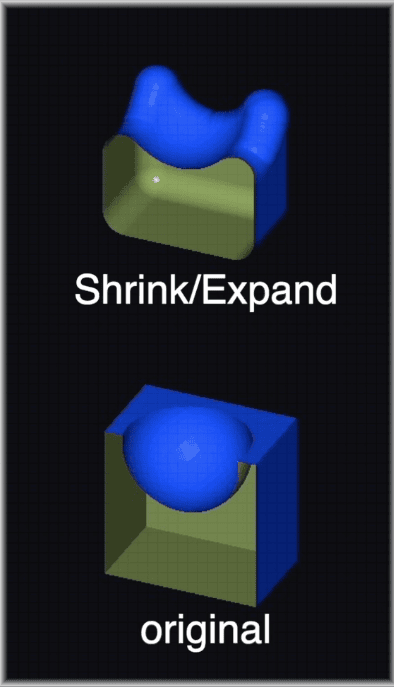
5. Shrink/Expand Mode
- Purpose: Smooths outward curves and decreases volume
- Process: First shrinks, then expands the mesh
Advanced settings let users fine-tune the offset process:
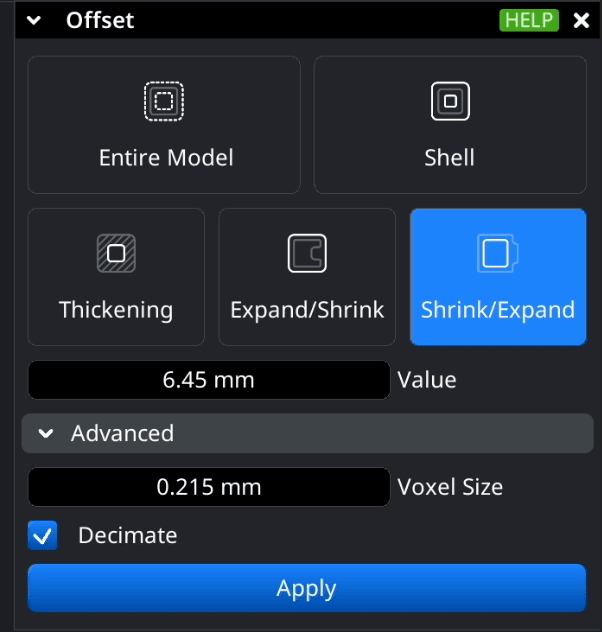
- Voxel Size controls surface detail level.
- Decimation simplifies the created surface to work better.
Here is the example of mesh offset code in MeshLib:
import meshlib.mrmeshpy as mrmeshpy
# Load mesh
mesh = mrmeshpy.loadMesh("mesh.stl")
# Setup parameters
params = mrmeshpy.OffsetParameters()
params.voxelSize = mesh.computeBoundingBox().diagonal() * 5e-3 # offset grid precision (algorithm is voxel based)
if mrmeshpy.findRightBoundary(mesh.topology).empty():
params.signDetectionMode = mrmeshpy.SignDetectionMode.HoleWindingRule # use if you have holes in mesh
# Make offset mesh
offset = mesh.computeBoundingBox().diagonal() * 0.05
result_mesh = mrmeshpy.offsetMesh(mesh, offset, params)
# Save result
mrmeshpy.saveMesh(result_mesh, "offsetMesh.stl")
#include <MRMesh/MRBox.h>
#include <MRMesh/MRMesh.h>
#include <MRMesh/MRMeshLoad.h>
#include <MRMesh/MRMeshSave.h>
#include <MRMesh/MROffset.h>
#include <MRMesh/MRRegionBoundary.h>
int main()
{
// Load mesh
MR::Mesh mesh = *MR::MeshLoad::fromAnySupportedFormat( "mesh.stl" );
// Setup parameters
MR::GeneralOffsetParameters params;
params.voxelSize = mesh.computeBoundingBox().diagonal() * 5e-3f; // offset grid precision (algorithm is voxel based)
if ( !MR::findRightBoundary( mesh.topology ).empty() )
params.signDetectionMode = MR::SignDetectionMode::HoleWindingRule; // use if you have holes in mesh
// Make offset mesh
float offset = mesh.computeBoundingBox().diagonal() * 0.05f;
auto meshRes = MR::generalOffsetMesh( mesh, offset, params );
if ( !meshRes.has_value() )
{
// log meshRes.error()
return 1;
}
// Save result
MR::MeshSave::toAnySupportedFormat( *meshRes, "mesh_offset.stl" );
return 0;
}
Find more examples in our documentation
Industries benefiting from using MeshLib's Mesh Offset
MeshLib’s Mesh Offset features offer numerous advantages in many fields:
3D Printing
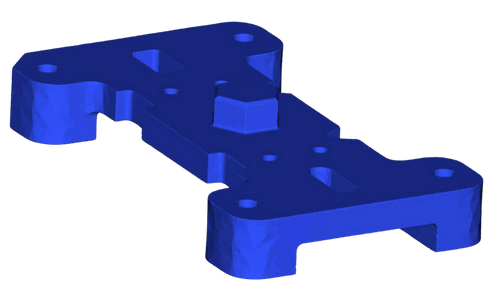

In 3D printing, Mesh Offset allows exact control of wall thickness, better support structures, and improved print quality.
Dental Industry

Dentists use Mesh Offset to design custom aligners and dental devices, ensuring they fit well and feel comfortable.
Why choose MeshLib SDK for Mesh Offsetting?
MeshLib leads in 3D processing, offering top-notch Mesh Offsetting that’s fast, precise, and versatile. It’s an open-source 3D geometry library that works with C++, C#, and Python, fitting easily into different projects and speeding up development. Its advanced methods and GPU boost make offsetting up to 10 times faster than other options, giving high-quality results even for complex meshes.
MeshLib works on different platforms and has a modern design without old limitations. This makes it the top choice for professionals who want to push the limits of 3D modeling and manufacturing in fields like 3D printing, CNC machining, and medical device design.
What our customers say

HeonJae Cho
DDS, MSD, PhD, Chief Executive Officer of 3DONS INC
"MeshLib SDK helped us achieve faster and more accurate calculation results and outperformed any other Mesh Processing library that we evaluated. For us in digital dentistry, it was a game-changer. Mesh processing operations, such as inspecting and editing the mesh to create dental devices for the treatment plan, are crucial. MeshInspector support liberated our team from technical constraints, so we concentrated on creating exactly what we wanted. I highly recommend incorporating MeshLib into your software arsenal."
Mariusz Hermansdorfer
Head of Computational Design at Henning Larsen Architechts
Over the past year, MeshLib has transformed my approach to design and analysis in landscape architecture and architecture projects. This powerful library excels in critical areas, such as geometry processing, interactive booleans, point cloud manipulation, and curve offsetting. These features enhance design workflows, allowing for dynamic modifications, efficient terrain modeling, stormwater flow analysis, and advanced wind flow visualiiza....."
MeshLib’s Mesh Offset features help professionals in many industries achieve new levels of precision and efficiency in their 3D modeling and manufacturing work. Using MeshInspector’s Offset tool, users can confidently tackle complex geometric challenges and produce better results.
Unlock the full potential of Mesh Offsetting with the MeshInspector with in-depth tutorials and demonstrations on our YouTube channel! Watch how MeshLib’s powerful tools can transform your 3D modeling and manufacturing processes.

